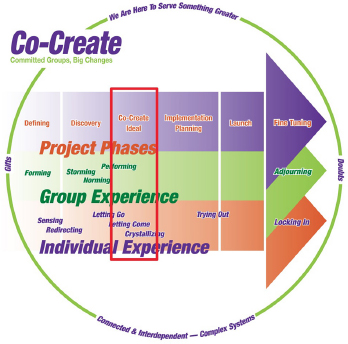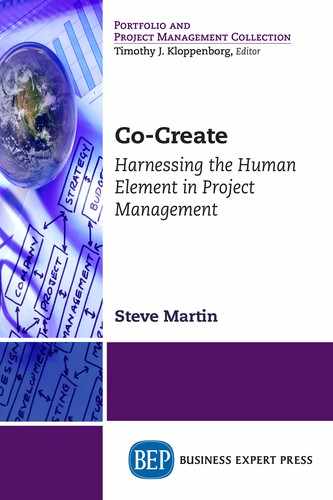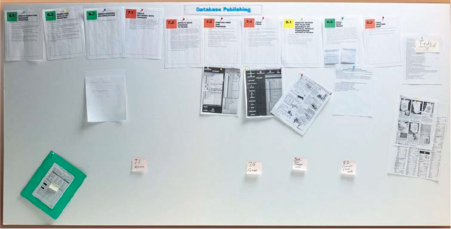Phase 3, Co-Create the Ideal, is where new possibilities emerge. All the prior work—defining a meaningful project, assembling the right group of people, doing the discovery work to understand the current state completely, and working through the emotional stuff—has positioned the group to co-create something great. The team facilitator has an important role to play and it begins with using questions to frame the next phase of work.

What’s Happening at Phase 3?
For the Project—Co-Create the Ideal
The objective of this phase is to create a new product or way of working—to define the ideal change that satisfies the desired outcomes of the project. The potential solution the team creates could be a brand new workflow, new structure, new guideline, new software, or even a new product strategy. Before starting, the team ensures their focus by reviewing their project objectives and deliverables as expressed in the whitepaper. And the team facilitator will walk the team through a review of the current state to ensure that they are ready to co-create. To begin, the team explores and answers questions such as:
• Ideally, what would accomplish our objectives?
• What might the ideal process look like?
• What do we want to create together?
• What needs to be different?
• What don’t we want to lose?
The team facilitator captures the information as the group begins to work. A blank whiteboard turns into a detailed solution as evidenced by new maps, workflows, artifacts, and other documents. The team’s work session notes, documented on whiteboards or flip charts, are messy and voluminous. Accurately capturing the information is critical and a challenge. The team may return to some of the analytical tools they used in Phase 2 to understand the current state to design the ideal future including process mapping, critical pathing, and mind maps.
This work can take 30 to 60 days depending on the project. Once the team has defined their recommended approach, they share it with the project sponsor to get their support and blessing to move forward.
For the Team—Performing
Phase 3 requires the team to work well together. It is important that storming and norming issues are worked out before getting to this part of the project. I have found that the data generation processes in Phase 2 enable team members to get to know each other and help them work through many of their concerns.
The team facilitator will structure team processes to bring out everyone’s ideas. This serves the project outcome and the team. During the performing phase of team development, ideas come from many team members and spawn new and creative approaches. Group interactions help move things forward, and mutual respect and energy are high.
For Individuals—Sensing-Letting Come/Crystallizing
New ideas become apparent on the individual level and are expressed in the group. This step can be overwhelming as it sometimes is a challenge to process all the new ideas. Minor personal doubts or concerns may still be present although most team members will feel willing to move forward. If the facilitator senses that significant unexpressed doubts or concerns are present they may elect to ask the group directly for their thoughts. If that does not work it may require some one-on-one work outside the meeting to explore the concern.
Many team members feel a sense of accomplishment when they get to the point of creating a tangible solution. One of the most significant outcomes of this stage is that it creates commitment and accountability. We tend to commit to solutions we create. This commitment is important for two reasons. First, the individuals on the team will be involved in training or communicating the change to the rest of the organization. Peer endorsement has tremendous credibility with the frontline staff. Secondly, implementing a significant change has some ups and downs. A committed individual will figure out the necessary adjustments needed to make the project a success.
Facilitators check in with team members a lot as they work through the process, and always at the end of each meeting. Example questions for this process check include:
• How are you feeling about the solution we’ve come up with?
• Do you feel it will accomplish the objectives?
• In two words give me your evaluation of our work today.
These questions can spawn great conversations as individuals and team members process the work. It helps crystallize or move a thought forward.
The most common pitfall during this phase occurs when we don’t give the group permission or encouragement to think broadly—it is important that divergent thinking occurs before converging on a solution.
Our facilitators also need to ensure that the focus on task achievement (coming up with a great idea) does not take their attention off what’s happening within the team. Ideas are important things to people. We do not want to inadvertently allow team members to feel disrespected or devalued.
The facilitator has to do a great job capturing and documenting information. This is best done at the end of the meeting while it is still fresh in the facilitator’s mind. It also includes working the data—taking the messy flipcharts and notes and getting them into presentable form. This can take a number of steps with the group reviewing what was captured and evaluating it for completeness or accuracy.
Considerations for Project Owners
This is the phase of the Co-Create model where project owners need to ensure that their actions and words communicate that they trust the process. It is easy to advocate opinions and ideas in ways that squelch the team’s creativity. It is also important that leaders encourage bold thinking and allow the team the time it takes to get beyond the most obvious answers. Even if the team ends up recommending one of their early ideas, the process they go through to consider more alternatives will serve the project outcomes well.
Conclusion
The team is ready to move on to Phase 4 when a defined and agreed-to solution has been achieved. The team should be a high performing unit and individuals should feel valued and ready to contribute their best efforts for the implementation phases of the project.
“Only by engaging can you influence. But engaging also means you will be influenced.” Peter Firestein
This image depicts an ideal process map. The top row documents the workflow while the artifacts below add clarity. We prefer this informal approach over creating a digital visual because team members can easily come up to the board and add or move things around. If you work with virtual teams, you will want to find a software program that creates this same inviting dynamic.

